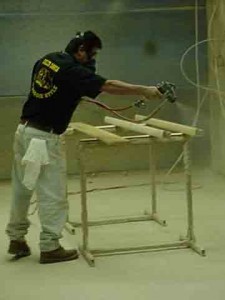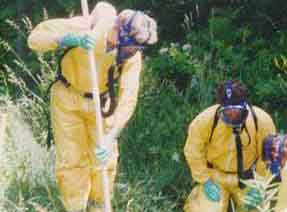Fri 8 Oct 2010
Spray Finish Air Monitoring
Posted by admin under Admin Controls, Engineering Controls, Personal Protective Equip (PPE), Respirators, Spray Finishing
Comments Off on Spray Finish Air Monitoring
To summarize, there is no real quick-fix to this type of industrial hygiene assessment. Depending on what type of spray finishing you are performing- will depend on how to proceed. Here are some things to look during your assessments of these areas:
- air flow across the face of the spray area should be at least 100 feet per minute
- review the MSDS for the products you spray, and the solvents, thinners, and A+B parts-everything.
- check the filters – are there scheduled changes? a manometer in place and used?
- no flammables should be inside the booth area
- watch the flow of work- usually there can be improvements- as well as lessons to learn
- is the employees’ skin protected during spraying? (obviously not in the picture-right)
- where does the waste (left over) spray product go?
- ask employees about concerns and health issues
Typically respirators are worn in the spray finish areas. This list is not complete, but for starter, check:
- what type of respirators are being worn? Are they protective enough?
- what type of cartridges are used? Are they changed regularly?
- are there scheduled change out times for their cartridges? where is that posted?
- where are their respirators stored?


